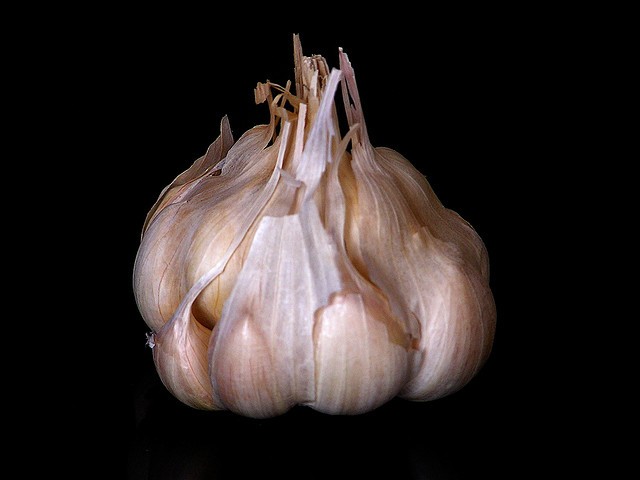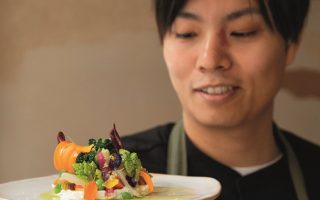Glorious Garlic

Perky isn’t a description I usually ascribe to garlic, but as I peeled a big, juicy new head recently, the word came to mind. Defined in my dictionary as “briskly self-assured”, perky is a near-perfect description of new garlic, those sturdy, proud heads that are taken from the ground several weeks before maturity. I would add lively to the definition, because few ingredients are as exciting on the palate.
New garlic is fully formed, but it hasn’t been left in the ground to dry. Instead, the head is layered in damp, thick skins that are more like cloth than paper. The cloves they hide are pearly white, and when the knife slices into one, a fine shower of scented mist covers knife, fingers and cutting board.
My first act with a new head of garlic is to extract a clove—no easy task, as it’s not quite ready to be separated from the head. Once done I peel the clove, thinly slice it, then thickly butter a slice of fresh baguette. I put a layer of the garlic slices over the butter, sprinkle them with fleur de sel, then close my eyes and eat the whole thing. Hot, juicy, spicy—garlic at its most essential.
Here in France we begin to see the heavy, purple-tinged heads of new garlic in early May. Shipped from Egypt, they are saviors, rescuing us from that bleak and garlic-less period that begins in late March. This year was no exception, despite the chaos of the Arab Spring. Somehow, Egyptian garlic farmers came through for us once more, and I blessed them doubly as I purchased my first head. Normally I am a devotee of buying local, but life is full of exceptions and new garlic from Egypt is one of mine.
The Egyptian new garlic is closely followed by its French cousin, which means we have this marvelously flavorful ingredient for almost six weeks each year.
Raw is one way to enjoy new garlic. Another dish that takes full advantage of its plenitude is a very special soup. To make it I simmer three heads worth of peeled cloves in water with a sprig of rosemary and a small potato until they are soft. I blend them, thicken them with an egg yolk, and then, right before serving, whisk an egg white and fold it into the mixture. Through an alchemy I don’t understand, the soup becomes an elegant, frothy cloud, perfect for serving in espresso cups, or small, dainty soup bowls. The flavor becomes milder with the cooking, but its elegance demands a small serving.
Now, in July, we are moving along towards mature garlic, which is usually harvested toward the end of the month. Gone is the bright perkiness of the new, replaced by the grounded, developed, profound flavor of the mature. I don’t use this mature garlic in my special soup, and I don’t slice it thin and eat it like a radish, with buttered bread and fleur de sel. Instead, I put it everywhere else.
Few garlic-based dishes are as French as aioli. Essentially a simple garlic mayonnaise, the first step in making it involves crushing a half-dozen cloves in a mortar with salt, reducing them to a fine and juicy puree. Blend in an egg yolk and a touch of mustard then, drop by drop, enough oil to make a thick sauce. I blanch vegetables and, if the event is special, poach salt cod with herbs and serve everything lukewarm. The spicy mayonnaise is a perfect accompaniment that few can resist.
Of course there are so many other things to do with garlic, and so many places to use it—another of my favorites is chicken with 40 cloves of garlic, which, when cooked together, become much more delicate than you would imagine. The options and opportunities for using garlic are, quite literally, endless. The history of garlic in Europe goes back to the Romans who, apparently, had a somewhat conflicted belief in its virtues. On one hand, it was issued to soldiers, who carried it with them on their campaigns throughout the continent, dropping cloves here and there that took root and prospered. On the other hand, the upper classes were not persuaded it was a good thing; the poet Horace called it “more poisonous than hemlock”.
In 1858, Louis Pasteur verified its antiseptic properties. As for its other properties, legends abound. One has it that a gang of thieves ransacked Marseille during the plague, its members kept safe by the “vinegar of four thieves”, a concoction of garlic, absinthe, rosemary, sage, and mint steeped in vinegar. Another says that garlic sprouted in the Garden of Eden from the left footprint of the devil; and yet another holds that a clove of garlic worn in the shoe warded off whooping cough. And of course, there is the oft-cited practice of wearing a clove of garlic—or perhaps an entire head—around the neck to keep vampires at bay.
France produces 18,500 tons of garlic per year, in areas scattered throughout the country. Several varieties have what is called an IGP (Indication Géographique Protégée), a European label that guarantees the region of production, and specific growing and preparation standards. Among the primary garlic varieties in France are l’ail rose de Lautrec (Midi-Pyrénées), l’ail blanc de Lomagne (Midi-Pyrénées), l’ail d’Auvergne, l’ail de la Drôme, l’ail de Provence, l’ail fumé d’Arleux (Nord-Pas-de-Calais), l’ail de Cherrueix (Bretagne) and l’ail violet de Cadours (Midi-Pyrénées), the only garlic with an Appellation d’Origine Controlée, a hard-won pedigree that underscores the quality as well as the cultivation and preparation of the garlic.
There are two major categories of garlic in France—that planted in spring and that planted in the autumn. Both are harvested in July. One of the more distinctive varieties is the mild ail rose de Lautrec, with a rigid central stem that makes it impossible to braid. Instead, growers first peel the heads down to the first skin, so the pink shows through, then tie it into fat, heavy bouquets.
Another variety that stands out is the golden smoked garlic of northern France. Its production is concentrated around the town of Arleux in the Pas-de-Calais region, and it represents ten percent of French garlic production. The cloves are pink, but smoking over a peat fire obscures their color and turns the outer skins deep golden and slightly sticky. The reason for the smoking is the climate. The north is damp, without enough sun to dry the garlic; the smoke preserves it, preventing it from getting moist and spoiling.
Garlic generally lasts well until Christmas, though certain varieties are given a mild heat treatment that extends their shelf life until May. Contrary to popular wisdom, garlic is best kept in a dark spot at room temperature. If there is a green germ inside a garlic clove, it should be removed. There is nothing wrong with it other than its texture, which is somewhat tough.
If you are reading this in July, the start of the garlic year is at hand. Take advantage, and add it to everything you can think of. But do as the French do—who consume about 1-1/2 pounds per capita per year—and use it with a dose of moderation, simply because it’s best that way.
AIOLI ( GARLIC MAYONNAISE)
This sauce evokes Provence at its productive best, in summer, when farms and family gardens are at their peak, yielding vegetables with an incomparable depth of flavor.
Note: When making aioli—or any mayonnaise-style sauce—think slow, slow, slow as you add the oil. If you do, then you’re guaranteed success. But if the aioli does separate, put an egg yolk in another bowl and slowly whisk the separated aioli into it.
6 garlic cloves, green germ removed
1 tsp sea salt
2 tsp Dijon mustard
3 large egg yolks
2 cups (500 ml) grape seed or other neutral oil
1/2 cup (120 ml) fine quality, extra-virgin olive oil
2 to 3 tsp freshly squeezed lemon juice
1. Make a paste of the garlic and salt in a mortar and pestle, by working the pestle around slowly, always in the same direction, in the mortar. If you don’t have a mortar and pestle, either finely mince the garlic with the salt, transfer it to a medium-sized bowl and press on it with a wooden spoon until it makes a rough paste; or simply mince the garlic and salt together in a food processor and transfer the mixture to a medium-sized bowl.
2. Whisk in the mustard and egg yolks until they are blended with the garlic and salt. Then, using either the pestle or a whisk, add 1/4 cup (60 ml) of the neutral oil very slowly in a fine, fine stream, until the mixture becomes thick. Don’t add the oil too quickly or the mixture will not emulsify.
3. Add 1 teaspoon of the lemon juice to the oil and garlic mixture, then add the remaining oil very, very slowly, whisking or turning the pestle constantly. The aioli will gradually thicken to the consistency of a light mayonnaise. Adjust the seasoning, and add more lemon juice if it needs more tang. If it becomes very, very thick you might add 1 tablespoon of warm water to loosen it.
4. Taste for seasoning and add salt if necessary. Aioli will keep for several days in the refrigerator, in an airtight container, but is best served within 24 hours of being made.
About 6 servings
Susan Herrmann Loomis teaches cooking classes in Normandy and Paris. www.onruetatin.com.
The latest of her ten books, Nuts in the Kitchen, is published by HarperCollins. Find it in the France Today Bookstore: www.francetoday.com/store
Originally published in the July/August 2011 issue of France Today
Share to: Facebook Twitter LinkedIn Email
Leave a reply
Your email address will not be published. Required fields are marked *




REPLY
REPLY
REPLY
REPLY